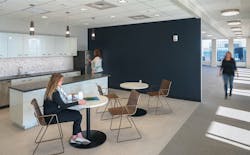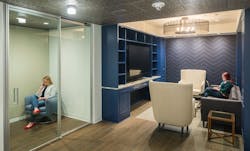At the ready: spec suites make hard-to-rent office space more attractive
By John Caulfield, Senior Editor
The office vacancy rate in the U.S., which stood at 12.9% in the fourth quarter of 2017, is expected to decline to around 12% over the next two years. But there are still areas of the country where vacancy rates continue to rise, leaving brokers and property managers with office spaces that, for a variety of reasons, just don't inspire renters.
Enter spec suites: ready-to-move-in offices that a growing number of owners are building out and brokers are marketing. These have become increasingly popular in certain markets, especially those where startup companies are in need of quick move-in or co-working solutions with shorter lease commitments.
This has been in a trend in some markets for a while. “Spec suites … are growing in popularity and in size, with new projects devoting entire floors and buildings to spec space,” reported the Colorado Real Estate Journal in 2016.
Spec suites have been catching on more recently in Washington, D.C., where office vacancies are up. Bisnow reported last October on a $60 million renovation of the 670,000-sf Metropolitan Square in which landlord Boston Properties is creating multiple spec suites, designed by Gensler, some larger than 19,000 sf. At Westwood Metro Tower in Tyson, Va., landlord MRP has converted two floors and 40,000 sf to spec suites ranging from 1,000 to 5,000 sf, revolving around a 3,500-sf two-floor amenity zone.
In Phoenix last September, Fin, a San Francisco-based virtual assistant company, agreed to lease an 8,081-sf spec suite in The Monroe office tower as its second location and first in Arizona. This lease “further highlights the demand for built-out, modern, move-in-ready office space,” said Bryan Taute, Executive Vice President with CBRE’s Phoenix office, which represented the building's landlord ViaWest Group. JLL represented the tenant.
ViaWest Group has since been building out additional spec suites in The Monroe, ranging from 1,500 sf to a full floor at 14,719 sf. Two contiguous spec suites on the fourth and fifth floors offer 21,208 square feet of combined office space with an available private rooftop patio.
In Boston, spec suites “have become part of many brokers’ marketing packages,” says Karen Bala, AIA, LEED AP, Senior Architect for the Dyer Brown, the design firm that over the years has worked on between 50 and 60 buildings in downtown Boston.
She tells BD+C that spec suites have been steadily coming onto the local real estate scene for the past few years. They are filling spaces that would be harder to rent otherwise, she explains, because they are on lower floors, are too small, or aren’t accessible to a lot of natural light.
“We’re doing a ton of these [spec suites] right now,” says Bala. Dyer Brown’s recent designs have ranged from as small as 3,000 sf, to as large as 30,000 sf.
A spec suite inside the office building at 100 Summer Street in Boston includes an intimate phone room and reception area. Image: Darrin Hunter, courtesy of Dyer Brown
Bala says spec suites typically include “must have” features such as a kitchen, a conference room, workspaces, and a reception area (which doesn’t need to be too elaborate or overly furnished). She notes that glass-enclosed “phone rooms,” where workers can talk in private, are now more popular than conference areas in these suites.
Renting spec suites entails a degree of market savvy, says Bala. First and foremost, landlords must understand their local codes about subdividing spaces. It is also “critical,” she says, for landlords and brokers to accentuate the positives about spec suites, and to make those spaces more appealing with better finishes and lighting.
She notes that the best spec suites “find a careful balance between the building owner’s own identity and the likely profile of incoming tenants,” says Bala.
Some spec suites use high-impact wall graphics and displays to tell a story about their building or neighborhood. Hospitality inspired designs with warmer colors, wood finishes and dimmable lights can attract many companies looking for a workplace that fits a more casual lifestyle or company culture.
Bala cautions that spec suites aren’t panaceas. In some cases, it might still be better simply to take the raw space and market that instead.
But spec suites can give tenants a more immediate sense of what they would be leasing. “The build-out always creates a more sensory experience, which can be much more impressive and convincing than a 3-D walk-through animation or detailed renderings,” Bala says.

